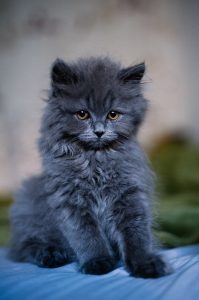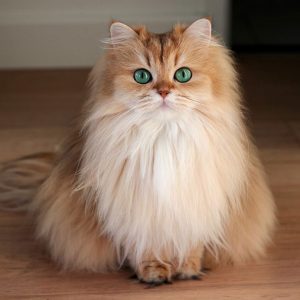Uncategorized
The Majestic British Longhair: A Regal Companion
The Grand Tapestry of History: From Ancient Roots to Global Recognition
 The British Longhair Cat Breed, known for its regal bearing and luxurious coat, shares a rich history with the British Shorthair. The breed’s origins trace back to cats that accompanied the Romans during their invasion of Great Britain. Likely originating from Egypt, these cats formed the foundation for one of the first recognized cat breeds.
The British Longhair Cat Breed, known for its regal bearing and luxurious coat, shares a rich history with the British Shorthair. The breed’s origins trace back to cats that accompanied the Romans during their invasion of Great Britain. Likely originating from Egypt, these cats formed the foundation for one of the first recognized cat breeds.
An Ancient Lineage: The British Shorthair, over centuries, has preserved its distinctive features. Breeders recognized the potential for refinement and introduced crosses with the Persian between 1914 and 1918. This deliberate introduction of the longhair gene marked a crucial phase in the development of the British Longhair.
From Shorthair to Longhair: The infusion of Persian genetics introduced the coveted longhair trait. This transformative period set the stage for the emergence of the British Longhair as a distinct and elegant feline companion.
Preserving Heritage: The Roots of the British Shorthair and the Emergence of the British Longhair
The saga of the British Shorthair unfolds with the arrival of cats from Egypt who accompanied the Romans during their invasion of Great Britain. This breed, one of the pioneers in the cat fancy world, has remained remarkably true to its origins over the centuries. As the British Shorthair evolved, strategic breeding decisions marked key milestones.
Between 1914 and 1918, breeders recognized the potential for refinement and introduced crosses with the Persian. This deliberate introduction of the longhair gene marked a crucial phase in the development of the British Longhair. The breed underwent a fascinating bifurcation, with short-coated cats retaining the British Shorthair mantle, while their longhaired counterparts found a place in Persian breeding programs.
In the early days, the blue shorthair exhibited two distinct archetypes: the robust, compact British with its characteristic round head, and the elongated, graceful Russian with its triangular head. These two types coexisted and were even interbred before eventually diverging into independent breeds.
The aftermath of World War I witnessed a pivotal moment for the British Shorthair. The Governing Council of the Cat Fancy (GCCF) mandated that only 3rd generation offspring of Persian/British Shorthair crosses could be presented in shows. This strategic decision, while reducing breeding stock, aimed to refine and elevate the breed’s standards. The challenges continued into World War II, impacting the British Shorthair’s trajectory.
Post-World War II, the British Shorthair faced a substantial setback as many of its bloodlines were nearly lost. In a concerted effort to revitalize the breed, breeders engaged in crosses with domestic shorthairs, Russian Blues, Persians, and other breeds. This collaborative breeding initiative contributed to the British Shorthair’s resurgence in popularity. Notably, in June 1979, the breed attained championship status in The International Cat Association (TICA), marking a significant milestone in its journey.
Amidst these endeavors, longhair kittens occasionally manifested in litters, representing a hidden facet of the British Shorthair. However, these longhaired felines lingered in relative obscurity as a distinct breed. It wasn’t until May 2009 that the majestic British Longhair earned its rightful place as a distinct companion breed, complementing the British Shorthair. Today, this imposing breed stands as a tribute to the heritage of Persians and Angoras from the early 1900s, embodying elegance and charm. The British Longhair, with its regal demeanor, has solidified its position by obtaining championship status in TICA, adding another chapter to the enduring legacy of these distinguished feline companions.
A Unified Elegance: Types of the Breed
While the British Longhair doesn’t have distinct types, its visual diversity is manifested through an array of coat colors. These include captivating hues like blue, cream, chocolate, and lilac. The breed shares its early lineage with the British Shorthair but distinguishes itself with its luxurious semi-longhair coat.
Exquisite Physique: A Symphony of Features
Colors: British Longhairs showcase a palette of colors, each contributing to their royal appearance. From the majestic blue to the enchanting lilac, their coat colors are a testament to their elegance.
Temperament: Known for their calm and easygoing temperament, British Longhairs make ideal companions. They are affectionate without being overly demanding, adding a touch of serenity to any household.
Body Shape and Face: Possessing a well-balanced physique, these cats have round faces adorned with large, expressive eyes that reflect their intelligence. Their ears are medium-sized and rounded, contributing to their endearing expression. A plumed tail adds to their majestic appearance.
Size and Weight: British Longhairs are medium to large cats, with males weighing between 13 to 18 pounds (6 to 8 kg) and females ranging from 9 to 13 pounds (4 to 6 kg). Their size and weight underscore their robust and healthy build.
Distinctive Features: The British Longhair’s semi-longhair coat and large, expressive eyes set it apart from other breeds. Their dignified appearance exudes an air of sophistication.
Recognition on the Global Stage
The British Longhair has rightfully earned its place among esteemed feline breeds with recognition from prominent cat associations. The International Cat Association (TICA) and other leading cat fancier organizations have embraced the British Longhair for its elegance and refined characteristics. This recognition has elevated the breed to international acclaim, celebrating its contribution to the diversity and beauty of the feline world.
Personality and Royal Habits
British Longhairs are celebrated for their gentle and affectionate personalities. They adapt well to routines and enjoy interactive play with their human companions. Their calm demeanor aligns them closely with the British Shorthair, but the longer coat of the British Longhair adds a touch of regality.
A Royal Reign: Lifespan
With attentive care, British Longhairs can enjoy a lifespan of 12 to 20 years. Regular veterinary check-ups, a nutritious diet, and a loving home environment contribute to their long and healthy lives.
Fascinating Facts and Quirky Tidbits
- The breed’s dense coat evolved as an adaptation to the cold British climate, showcasing the practical origins of their regal appearance.
- Despite their dignified demeanor, British Longhairs are known to engage in playful antics, adding a delightful touch of humor to their personality.
- These cats often form strong bonds with their owners, following them around the house and participating in family activities.
Advice for Cherished Companions
Caring for a British Longhair involves regular grooming sessions to maintain their luxurious coat. Brushing a few times a week helps prevent matting and reduces shedding. A balanced diet, regular exercise, and routine veterinary check-ups ensure a healthy and happy life for these majestic companions.
In conclusion, the British Longhair, with its captivating history, striking appearance, gentle temperament, and international acclaim, is a breed that brings both elegance and warmth to the homes fortunate enough to host them. As stewards of these regal cats, providing love, care, and attention ensures a harmonious and enduring companionship.
Privacy Policy
Meow Cats takes your privacy seriously. This privacy policy describes what personal information we collect and how we use it.
Routine Information Collection
All web servers track basic information about their visitors. This information includes, but is not limited to, IP addresses, browser details, timestamps and referring pages. None of this information can personally identify specific visitors to this site. The information is tracked for routine administration and maintenance purposes.
Cookies and Web Beacons
Where necessary, Meow Cats uses cookies to store information about a visitor’s preferences and history in order to better serve the visitor and/or present the visitor with customized content.
Advertising partners and other third parties may also use cookies, scripts and/or web beacons to track visitors to our site in order to display advertisements and other useful information. Such tracking is done directly by the third parties through their own servers and is subject to their own privacy policies.
Controlling Your Privacy
Note that you can change your browser settings to disable cookies if you have privacy concerns. Disabling cookies for all sites is not recommended as it may interfere with your use of some sites. The best option is to disable or enable cookies on a per-site basis. Consult your browser documentation for instructions on how to block cookies and other tracking mechanisms.
Special Note About Google Advertising
Any advertisements served by Google, Inc., and affiliated companies may be controlled using cookies. These cookies allow Google to display ads based on your visits to this site and other sites that use Google advertising services. Learn how to opt out of Google’s cookie usage. As mentioned above, any tracking done by Google through cookies and other mechanisms is subject to Google’s own privacy policies.
Contact Information
Concerns or questions about this privacy policy can be directed to meowcatsmail@gmail.com for further clarification.